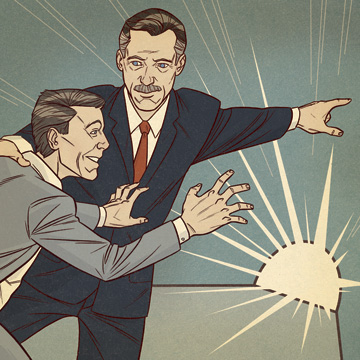The economic news is still grim. C-suite residents privately tell me Washington is making bad decisions with far-reaching implications. But
your job, as a CEO, is to be a leader—and leaders create hope. Do not confuse “hope” with Pollyanna-type “happy news.” The hope that a leader conveys is a sense of dedication, perseverance, commitment, fortitude, and enthusiasm for the opportunity and blessings we enjoy in this country.
Despite the horrible publicity on a handful of self-serving, tone-deaf individuals who confused career ascendance with divinity—those are the words of Jim Kouzes, from the Center for Innovation and Entrepreneurship at Santa Clara University—the overwhelming majority of CEOs are honorable, caring people. We have a heritage over more than two centuries of leaders with “indomitable souls,” as William Thackeray described George Washington’s attitude during the American revolution. One of the strings attached to leadership is the responsibility to carry on this commitment, recognizing that, in times like these, it may be a lonely task.
In a recent column in BusinessWeek, Jack and Suzy Welch wrote that it’s important to motivate yourself, to muster your own self-confidence, and to remember that you’re in charge of the overall mission. “The minute you start doubting yourself, you run the risk of falling into a self-created vortex of defeat,” they wrote. Remember, it is a mission—a very powerful word. (There’s a reason NASA calls them “missions” and not “trips.”)
Keep saying, “We can do it,” just the way Chesley “Sully” Sullenberger III did when CBS’s Katie Couric asked him if he’d been afraid he might not get his US Airways jet down safely in the Hudson River. Capt. Sullenberger replied with simplicity and dignity: “No. I knew I could do it.”
Samuel Adams, cousin to founding father and U.S. President John Adams, was the Winston Churchill of the American Revolution, constantly exhorting Americans to believe they could accomplish independence and warning, “If we despond, public confidence is destroyed.”
What you do not do is offer the false promise that everything will be just fine. One of the rules we teach is that in any crisis, always ask, “What’s the strongest truthful statement we can make?” What the CEO can say today is that he or she values every single one of his people, that he respects and appreciates the effort and determination they display, and that the team is putting forth its best effort.
Of course, these are things the CEO should be saying frequently even in good times. But study after study shows that management under-communicates. A recent study by the Center for Work-Life Policy and Sylvia Ann Hewlett Associates found that executives were “angry, anxious, and deeply stressed,” and that employees’ loyalty, engagement, and trust plummeted in the last year. In a recent article in the Academy of Management Perspectives, three business-school professors commented on the importance of “intrinsic motivation,” saying that leadership “neglect[s] to appreciate the importance of the environment.”
Now, more than ever, it’s the CEO’s job to understand and foster an environment where people believe we can get through tough times. John Gardner, the founder of Common Cause, author, and cabinet secretary, wrote, “The first and last task of a leader is to keep hope alive.” You can do this.
Spaeth is one of the country’s leading communications strategists. After serving as President Ronald Reagan’s director of media relations, she founded Dallas-based Spaeth Communications in 1987. She is also a lecturer at Southern Methodist University’s Cox School of Business.
THE KINDEST (POSSIBLE) CUTS
Or: How to right-size your staff without destroying your company
Include Human Resources in the process of deciding who will be laid off and whose job will be saved.
Offer the option of salary freezes or pay cuts before laying off employees.
Furlough staff in hopes that good times will return.
Provide strong severance packages to employees who must be laid off.
After layoffs, realize that employees aren’t interchangeable. Some jobs will not be done.
Reduce work weeks to four-day stretches.
When making cuts, take care not to sully the brand you’ve spent years building up.
—DAVE MOORE
Source: An employment-related discussion by Birkman International Inc. and Stanton Chase International at The Northwood Club in Dallas.





